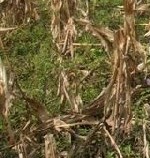In addition to be used as a trap plant in the push-pull technology, Napier grass is the most important fodder crop in smallholder dairy production systems in East Africa, characterized by small zero grazing units. The major threat to adoption and expansion of the push-pull technology, and to the smallholder dairy industry, is the stunt disease of Napier grass . The etiology of the disease is known to be a phytoplasma, 16SrXI strain. Although, the putative insect vector was yet unknown, we have recently identified a leafhopper, Recilia banda Kramer (Hemiptera: Cicadellidae) as the vector of Napier stunt phytoplasma in Kenya, and may be the key vector of the stunt disease in this region. Since R. banda is phytophagous on the family gramineae, and based on 16S sequence analysis, there are similarities among Napier stunt phytoplasma and those pathogenic to important grasses. This raises the possibility of the Napier stunt phytoplasma infecting other economically important grasses and crop species in East Africa and beyond. Use of resistant varieties as a component of an integrated management approach could be an environmentally friendly way to contain this disease in smallholder dairy industry. There is a wide variety of Napier grass cultivars in East Africa, and therefore, following the identification of the vector we have initiated screening for resistant cultivars and development of an integrated management approach for the disease. Studies on vector biology and vector–pathogen-plant interactions are being conducted in addition to evaluations of the other leafhoppers and plant hoppers associated with Napier grass for identification of any additional vector species. An effective management approach for the disease will save the smallholder dairy and cereal farming systems in the region and the many farm households dependent on these systems. << Back


 Research Partners
Research Partners